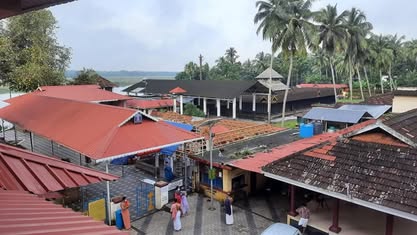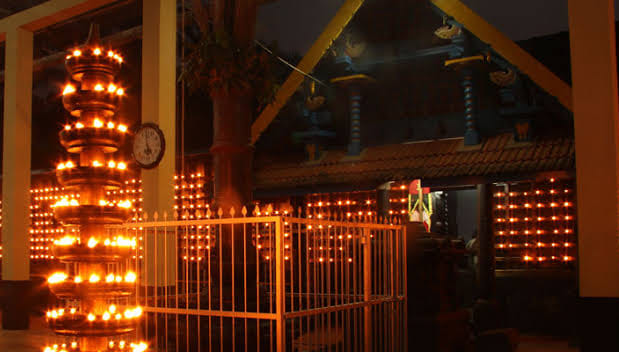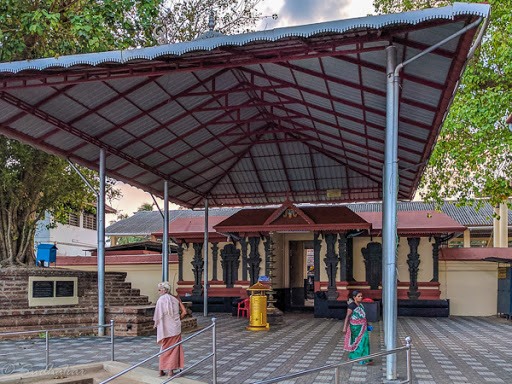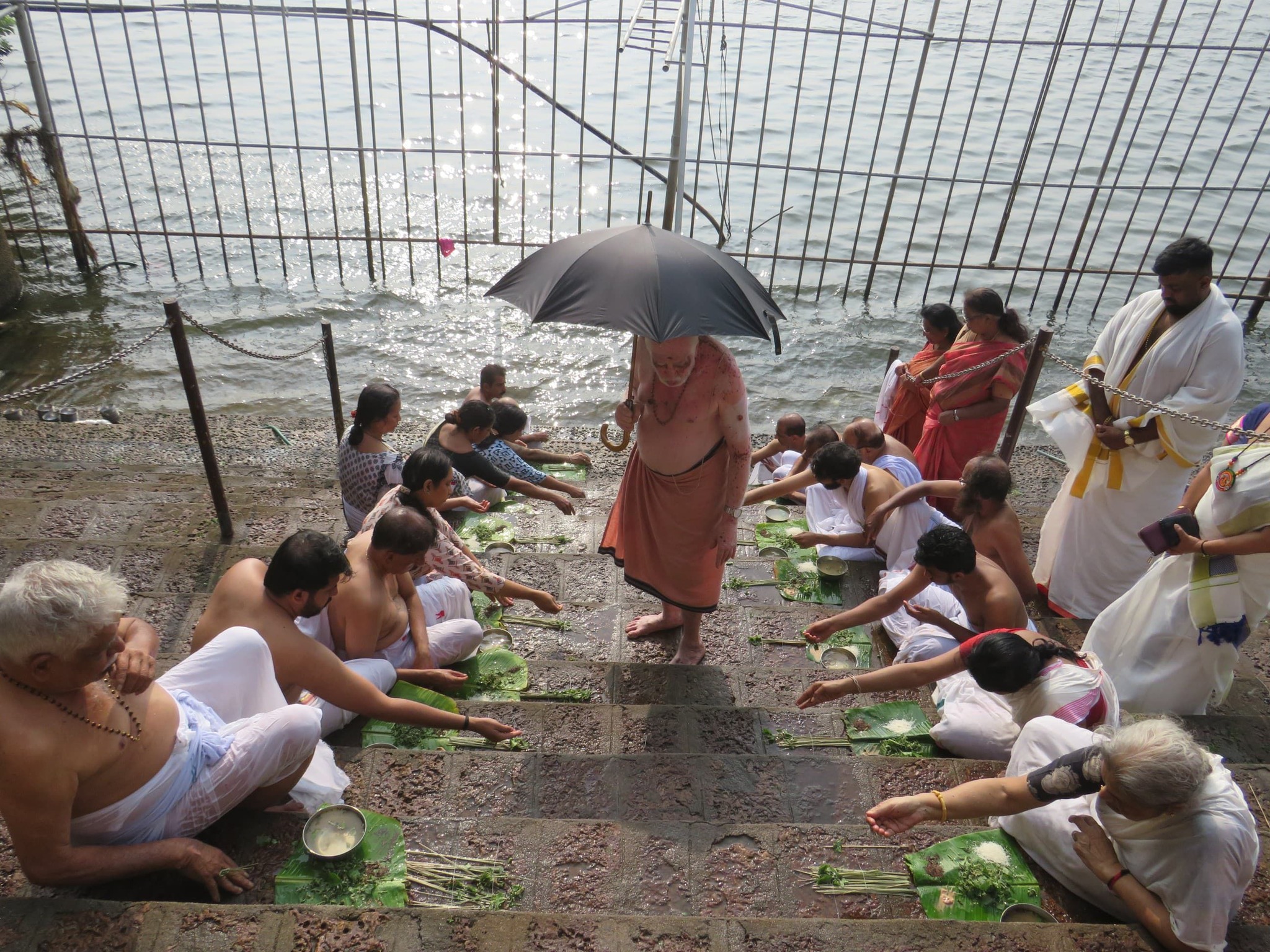Tirunavaya Navamukunda Temple is a revered ancient Hindu temple located in Tirunavaya, central Kerala, on the northern bank of the Bharathappuzha (River Ponnani), dedicated to Lord Vishnu in the form of Navamukunda (Narayana).
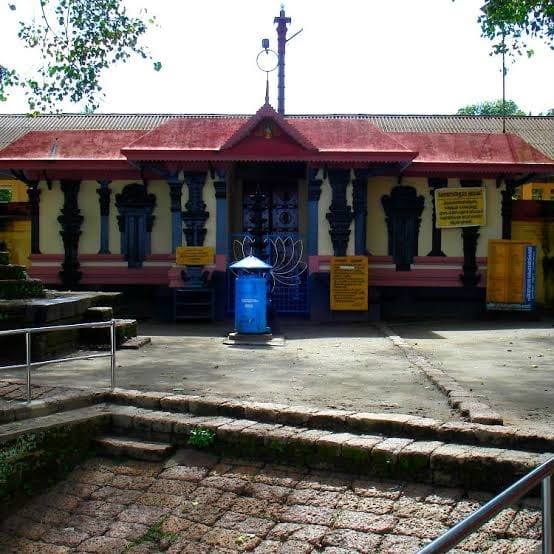
Celebrated in the Divya Prabandha, a collection of early medieval Tamil hymns by the Vaishnava Alvars, it is one of the 108 Divya Desams, sacred abodes of Vishnu. Notably, the temple lacks a traditional pond or well; instead, it uses water from the Bharathappuzha for all rituals. The nearby temples of Brahma and Shiva across the river in Tavanur form a rare Trimurti sangama.
The riverbank at Tirunavaya is considered as holy as Kashi, making it a significant site for ancestral rituals (bali tarpana/sraddha puja). The temple also houses deities such as Ganapati (Adi Ganesa/Gajendra), Goddess Lakshmi (Malarmangai Nachiyar) with a separate sanctum, and Lord Ayyappa.
Historically, the temple was the grand venue for the Mamankam festival, celebrated every 12 years from at least the 8th century CE. It suffered destruction during Tipu Sultan’s invasion in the 18th century and again during the Mappila Rebellion in 1921. The current structure is built in the traditional Kerala temple architectural style.
Today, the temple is under the administration of the Zamorin of Calicut (Samutiri), serving as the managing trustee under the Malabar Devaswom Board, Government of Kerala. The temple is open daily from 5:00 am to 10:00 am and from 4:00 pm to 7:00 pm, with extended timings during festivals. The presiding deity at Tirunavaya Temple is known as "Navamukunda Perumal" or "Navamukunda Tevar" because the current idol is believed to be the ninth one installed by a group of nine Hindu sages called the Navayogis. The first eight idols reportedly sank into the earth upon installation, and the ninth idol also began to sink but was stopped at the knees, which is why it still remains partially submerged.
Since the earlier idols were lost beneath the ground, devotees traditionally performed pradakshina (circumambulation) on their knees as a mark of reverence—this practice was followed by all, including high-ranking figures like the Alvancheri Tamparakkal and Tirunavaya Vaddhyans. Due to this connection, the temple site is also called Navayogisthala.
According to legend, both Goddess Lakshmi and Gajendra, the elephant king, worshipped Lord Vishnu here using lotus flowers from the same lake. As the flowers became scarce due to both using them, Gajendra prayed for help, and Vishnu, moved by his devotion, placed Lakshmi beside him on the same throne and accepted Gajendra’s offerings.
The present Tirunavaya Navamukunda Temple is constructed in the traditional Kerala Temple Architecture style, which is commonly seen across temples in the region. A rectangular outer wall known as kshetra-matilluka, with gateways, encloses the entire temple complex. The metal-plated flag post (dvaja sthambha) is positioned in line with the entrance tower, leading toward the sanctum, and is accompanied by a dipasthambha (lamp post). The chuttambalam serves as the outer pavilion within the temple walls, while the inner temple complex, including the main shrine and associated halls, is housed in the nalambalam, a rectangular structure with pillared halls and corridors.
Between the nalambalam entrance and the sanctum lies the namaskara mandapa, a raised square platform with a pyramidal roof. To its left is the thevrapura or temple kitchen, where offerings for the deity are prepared. The balithara, an altar for ritual offerings to demi-gods and festival deities, is also present within the complex. The sanctum sanctorum, known as sri kovil, houses the idol of Navamukunda and is elevated with access via five steps. Guardian deity sculptures (dvarapalakas) flank the single entrance. As per Kerala temple traditions, only the chief priest (tantri) and the second priest (melsanti) are permitted to enter the sanctum.
The central shrine of Tirunavaya Navamukunda Temple is built on a square plan, with a granite base, laterite superstructure, and a conical terracotta-tiled roof supported by an internal wooden framework. The two-tiered roof design protects the inner sanctum from monsoon rains and features elaborate wood and stucco carvings depicting scenes from the Ramayana and Mahabharata. The outer sanctum walls are lined with wooden frames that hold oil lamps, which are lit during festivals, creating a radiant atmosphere.
The idol of Navamukunda is 6 feet tall and made of stone covered with panchaloha (five-metal alloy). It is only visible from above the knees, as the rest is embedded in the ground, with a legendary bottomless pit believed to lie behind it.
The deity stands facing east, holding the Panchajanya conch, lotus flower, Kaumodaki mace, and Sudarshana chakra in his four hands.
A separate sri kovil (sanctum) for Goddess Lakshmi is located in the northwest corner of the nalambalam, to the left of Navamukunda’s sanctum. Her idol faces east and is depicted with two hands in the varada (boon-giving) and abhaya (protection) mudras. Tirunavaya Navamukunda Temple is renowned for Pitru Tharpanam—ritual offerings to ancestors.
തിരുനാവായ നാവാമുകുന്ദക്ഷേത്രം
മലപ്പുറം ജില്ലയിലെ തിരൂർ താലൂക്കിൽ ഭാരതപ്പുഴയുടെ തീരത്ത് സ്ഥിതി ചെയ്യുന്ന പ്രസിദ്ധമായ ഹിന്ദു ക്ഷേത്രമാണ് തിരുനാവായ നാവാമുകുന്ദ ക്ഷേത്രം. പുരാതനതും വൈഷ്ണവപരവും ആയ ഈ ക്ഷേത്രത്തിൽ ത്രിമൂർത്തികളിലൊരായ ശ്രീ മഹാവിഷ്ണു ആണ് മുഖ്യപ്രതിഷ്ഠ. ഇവിടത്തെ മഹാവിഷ്ണു ഭഗവാൻ നാവാമുകുന്ദൻ എന്ന പേരിലാണ് അറിയപ്പെടുന്നത്. ഐതിഹ്യപ്രകാരം, നവയോഗികൾ എന്നറിയപ്പെടുന്ന ഒമ്പത് മഹാസന്ന്യാസിമാരാണ് ഇവിടെ വിഗ്രഹങ്ങൾ പ്രതിഷ്ഠിച്ചത്. ആദ്യം പ്രതിഷ്ഠിച്ച എട്ട് വിഗ്രഹങ്ങൾ ഭൂമിയിലേക്ക് ഉൾക്കൊണ്ടുപോയി എന്നാണ് വിശ്വാസം.
ഒമ്പതാമത്തെ വിഗ്രഹം സ്ഥിരപ്പെടുത്തിയതായാണ് ധാരണ. അതിനാൽ തന്നെ ഈ ക്ഷേത്രം നാവായോഗിസ്ഥലം എന്നും അറിയപ്പെടുന്നു.ഇന്ത്യയിലെ 108 ദിവ്യദേശങ്ങളിൽ കേരളത്തിൽ ഉൾപ്പെട്ടിരിക്കുന്ന പതിനൊന്നിൽ ഒന്നാണ് തിരുനാവായ ക്ഷേത്രം. നാവാമുകുന്ദൻ ഭഗവാനെയും, ലക്ഷ്മിദേവിയെയും ചേർന്നുള്ള ലക്ഷ്മീനാരായണ സങ്കല്പത്തിലാണ് ഇവിടെ പ്രതിഷ്ഠയും ആരാധനയും. ഉപദേവതകളായ ഗണപതി, അയ്യപ്പൻ എന്നിവർക്കും ക്ഷേത്രത്തിൽ സന്നിധിയുണ്ട്. പ്രധാന ശ്രീകോവിലിന് പിറകിൽ ശിവന്റെ പ്രതീകമായ നന്ദി വിഗ്രഹവും സ്ഥിതി ചെയ്യുന്നു. ഇത് സമീപത്തുള്ള തൃപ്രങ്ങോട് ശിവക്ഷേത്രവുമായി ബന്ധപ്പെട്ടു കാണപ്പെടുന്നു.
മേടമാസത്തിലെ വിഷുസംക്രമദിനത്തിൽ ആരംഭിക്കുന്ന കൊടിയേറ്റുത്സവം പത്താമുദയത്തിന് ആറാട്ടോടെ സമാപിക്കുന്നു. ഈ പത്തു ദിവസം നീണ്ടുനിൽക്കുന്ന ഉത്സവം വളരെ വിശേഷപ്പെട്ടതാണ്. കൂടാതെ കുംഭമാസത്തിലെ വെളുത്തപക്ഷ ഏകാദശി, ചിങ്ങത്തിലെ തിരുവോണം, കന്നിയിലത്തെ നവരാത്രി, ദീപാവലി, വൈകുണ്ഠ ഏകാദശി (സ്വർഗ്ഗവാതിൽ ഏകാദശി), വൈശാഖ പുണ്യകാലം എന്നിവയും ക്ഷേത്രത്തിൽ വലിയ ആചാരപരവും ഭക്തിപൂരിതവുമായ രീതിയിൽ ആചരിക്കുന്നു.
വ്യാഴാഴ്ച മഹാവിഷ്ണുവിനും, വെള്ളിയാഴ്ച മഹാലക്ഷ്മിക്കുമാണ് പ്രത്യേകത. ക്ഷേത്രഭരണം മലബാർ ദേവസ്വം ബോർഡിന്റെ കീഴിലാണ്.ആയിരക്കണക്കിന് വർഷങ്ങളായി നിലനിൽക്കുന്ന ഈ ക്ഷേത്രത്തെക്കുറിച്ചുള്ള പ്രധാന ഐതിഹ്യങ്ങളിൽ ഒന്നാണ് ഒൻപതു യോഗിമാർ പ്രതിഷ്ഠ ചെയ്ത വിഗ്രഹങ്ങളുടേതുള്ളത്. ഇതനുസരിച്ച്, ഒൻപത് മഹാസന്ന്യാസികൾ ഭഗവാനായ മഹാവിഷ്ണുവിന്റെ വിഗ്രഹം ഇവിടെ പ്രതിഷ്ഠിക്കാൻ ശ്രമിച്ചെങ്കിലും ആദ്യ എട്ട് വിഗ്രഹങ്ങളും ഭൂപ്രവേശം ചെയ്തു മറഞ്ഞുപോയി. ഒൻപതാമത്തെ പ്രതിഷ്ഠ മാത്രമാണ് ഉറച്ച് നിന്നതെന്നും, അതും "പാൽപായസം പ്രതിദിനം നിവേദ്യം ആയി സമർപ്പിക്കണമെന്ന" വ്യവസ്ഥയിൽ മാത്രമാണെന്നും ഐതിഹ്യത്തിൽ പറയുന്നു. അതിനാലാണ് ഈ ഭഗവാൻ "നവാമുകുന്ദൻ" എന്ന പേരിൽ അറിയപ്പെടുന്നത്.
ആയിരക്കണക്കിന് വർഷങ്ങളായി നിലനിൽക്കുന്ന ഈ ക്ഷേത്രത്തെക്കുറിച്ചുള്ള പ്രധാന ഐതിഹ്യങ്ങളിൽ ഒന്നാണ് ഒൻപതു യോഗിമാർ പ്രതിഷ്ഠ ചെയ്ത വിഗ്രഹങ്ങളുടേതുള്ളത്. ഇതനുസരിച്ച്, ഒൻപത് മഹാസന്ന്യാസികൾ ഭഗവാനായ മഹാവിഷ്ണുവിന്റെ വിഗ്രഹം ഇവിടെ പ്രതിഷ്ഠിക്കാൻ ശ്രമിച്ചെങ്കിലും ആദ്യ എട്ട് വിഗ്രഹങ്ങളും ഭൂപ്രവേശം ചെയ്തു മറഞ്ഞുപോയി. ഒൻപതാമത്തെ പ്രതിഷ്ഠ മാത്രമാണ് ഉറച്ച് നിന്നതെന്നും, അതും "പാൽപായസം പ്രതിദിനം നിവേദ്യം ആയി സമർപ്പിക്കണമെന്ന" വ്യവസ്ഥയിൽ മാത്രമാണെന്നും ഐതിഹ്യത്തിൽ പറയുന്നു. അതിനാലാണ് ഈ ഭഗവാൻ "നവാമുകുന്ദൻ" എന്ന പേരിൽ അറിയപ്പെടുന്നത്.
ക്ഷേത്രത്തിനടിയിൽ ഇപ്പോഴും ആ എട്ട് വിഗ്രഹങ്ങൾ സ്ഥിതി ചെയ്യുകയാണെന്നും വിശ്വാസം നിലനിൽക്കുന്നതിനാൽ, ഇവിടെ സമ്പൂർണ്ണ പ്രദക്ഷിണം സാധാരണയായി നടത്താറില്ല. അതിനുപകരമായി, ആഴ്വാഞ്ചേരി തമ്പ്രാക്കൾ, തിരുനാവായ വാദ്ധ്യന്മാർ തുടങ്ങിയവർ ക്ഷേത്രത്തിൽ മുട്ടുകുത്തിയാണ് പ്രദക്ഷിണം നടത്തുന്നതും ഭഗവാനെ തൊഴുന്നതുമായിരുന്നു. ഇന്ന് വരെ ഈ ആചാരങ്ങൾ ചില ഭക്തർ നിലനിർത്തുന്നതായി കാണാം.
ഇതൊക്കെ ചേർന്നാണ് തിരുനാവായ നാവാമുകുന്ദക്ഷേത്രം ഐതിഹ്യങ്ങളും ആചാരങ്ങളുമായ വിശിഷ്ടമാകുന്നത്, അത് മലയാള സംസ്കാരത്തിലും ധാർമ്മിക ചരിത്രത്തിലും വലിയ സ്ഥാനം നേടിയിട്ടുണ്ട്.
തിരുനാവായ നാവാമുകുന്ദക്ഷേത്രത്തിലെ പ്രധാന പ്രതിഷ്ഠ ലക്ഷ്മിസമേതനായ നാരായണനാണ് എന്നതിന്റെ തെളിവായി പുരാതന തമിഴ് ദിവ്യപ്രബന്ധത്തിൽ പരാമർശം കാണുന്നു. അത്യപൂർവമായ ശിലയിൽ നിർമ്മിച്ച ചതുര്ബാഹു വിഗ്രഹമാണ് ഭഗവാൻ, ഇപ്പോൾ പഞ്ചലോഹത്തിലൂടെ പൊതിഞ്ഞിരിക്കുന്നു, ഏകദേശം നാലടി ഉയരമുള്ള ഈ വിഗ്രഹം ശംഖചക്രഗദാപദ്മങ്ങൾ ധരിച്ചുനിൽക്കുന്ന നിലയിൽ കിഴക്കോട്ട് ദർശനമായ ചതുരശ്രീകോവിലിൽ സ്ഥിതി ചെയ്യുന്നു. ക്ഷേത്രത്തിന്റെ ആർക്കിടെക്ചർ അതീവ സൂക്ഷ്മതയോടെയാണ് രൂപകൽപ്പന ചെയ്തത്; വിഷുസംക്രമദിവസം ഭഗവാന്റെ പാദാരവിന്ദങ്ങളിൽ ഉദയസൂര്യന്റെ കിരണങ്ങൾ പതിക്കുന്ന വിധത്തിൽ ശ്രീകോവിലിന്റെ നിർമിതിയുണ്ട്.
ഗുരുവായൂർ ക്ഷേത്രത്തോടുള്ള സാമ്യങ്ങൾ കാഴ്ച്ചവെക്കുന്ന രീതിയിൽ കൊടിമരം, ബലിക്കല്ല് എന്നിവയുടെ ക്രമീകരണമുണ്ട്, പ്രധാനകവാടത്തിൽനിന്നുതന്നെ ഭഗവാൻ ദർശനമാകുന്നത് ക്ഷേത്രത്തിന് അതീവ വൈശിഷ്ട്യമേകുന്നു. ആദ്യം പ്രതിഷ്ഠിച്ച എട്ടു വിഗ്രഹങ്ങൾ അന്തർദ്ധാനം ചെയ്തതായ ഐതിഹ്യത്തെ തുടർന്ന്, പഴയകാല ഭക്തജനങ്ങൾ ഭവനഭൂമിയിൽ മുട്ടുകുത്തിയാണ് ദർശനം നടത്തുന്നത്, വിഗ്രഹത്തിന് മീതെ ചവിട്ടരുതെന്ന കർശനനിയമം അവർ കൃത്യമായി പാലിച്ചിരുന്നതായും ഐതിഹ്യങ്ങൾ പറയുന്നു, എന്നാൽ ഇന്നത്തെകാലത്ത് ആചാരങ്ങൾ ശീഥീലമായ സാഹചര്യത്തിൽ സാധാരണക്ഷേത്രങ്ങളിലേതുപോലെ ദർശനം നടക്കുന്നു. പ്രതിഷ്ഠയുടെ പേരിനെച്ചൊല്ലി 'നാവാമുകുന്ദൻ' ആണോ 'നവമുകുന്ദൻ' ആണോ എന്നുള്ള തർക്കങ്ങൾ നിലനിൽക്കുമ്പോഴും, നവയോഗിമാരുടെ ഒൻപതാമത്തെ പ്രതിഷ്ഠയുമായി ബന്ധപ്പെട്ട മുക്തിപ്രദനായ ഈ ഭഗവാൻ പൊതുഭക്തിയിൽ 'നാവാമുകുന്ദൻ' എന്ന പേരിലാണ് പ്രശസ്തനായത്.
